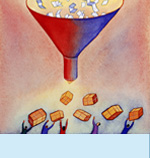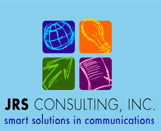| |
|
PRINTER FRIENDLY VERSION
What are Your Customers and Employees Thinking? The Value of an Outside-In Perspective
"Oh what a gift the Gods would give
us
To see ourselves as others see us"
- The poetry of Robert Burns
Do you know how your customers and employees view your products
and services? Are your communications meaningful? All you have to
do is ask. It may seem obvious, but you can significantly increase
your effectiveness in promoting a brand and as a communicator just
by asking for input from the very people who you are trying to reach.
For example, we tested a multi-million dollar advertising campaign
that positioned a global travel organization as a wonderful employer,
promoting a good work atmosphere and benefits. However, employees
in our focus groups argued that the claims were untrue. Further
investigation at corporate headquarters revealed that the employment
conditions described in the advertising were not universal among
all locations, and the campaign was scrapped.
This insight was invaluable. Releasing the campaign could have led
to both unflattering media coverage of our client as well as negative
backlash from employees wondering why they didn't receive the
benefits described in the ads.
Simply put, understanding how your employees and customers view
your brand and your communications reduces your margin of error.
After all, even the highest quality, most professionally produced
communications program and materials will fall flat if their contents
aren't compelling to the intended audience. When your brand positioning
and communications are based on your target audiences' needs
and motivations, you can be confident that they will be meaningful
to the people that you are seeking to reach — a pull rather
than push strategy.
I recently attended a seminar in which a healthcare marketing professional
unveiled a television ad campaign that promoted her organization's
new positioning. In the question and answer session, I was astounded
to learn that both the positioning and the campaign were based entirely
on direction from the company's marketing department, executive
management team and advertising agency, without input from non-marketing
employees or customers. This organization had decided how to position
itself and had produced a six figure ad campaign promoting that
positioning, with no idea whether the positioning and campaign were
credible or compelling to the people they were trying to reach.
What this company hadn't considered was that customers and employees
outside of the marketing department often think quite differently
than those of us in the marketing business. As a store manager once
explained to me, "I'm in the sporting goods business. I'm not
a marketing guy. They send me this marketing information from home
office and I don't understand all of the words they use, but I'm
too embarrassed to call and ask them to explain."
The only way to know if non-marketing audiences understand the message
is to actually run it by them. When we test a positioning or campaign
in focus groups or interviews, we explore three core criteria among
target customers or employees:
• Is the message credible?
• Is it compelling? (Does it answer the "So what?"
factor?)
• Does it differentiate the brand from competitors?
It's quite possible for a campaign to pass one of our criteria's
tests but fail another. In our earlier example about the employment
advertising campaign, customers found the generous benefits and
opportunities described to be both intriguing and compelling. However,
they wondered if they were true. When the current employees cried
foul, it was time to kill the campaign.
Exploring audience product and service needs and reactions to communications
both increases your effectiveness and saves money. We use advanced
statistics in our communications surveys of employees to identify
the key drivers of effective communications. By key drivers, we
mean the strategies and tactics that are most likely to produce
a desired outcome, i.e. employees feeling informed or staff supporting
a merger or reorganization.
This process allows us to advise our clients where they should focus
resources in order to really move the needle on achieving better
business results. The pay-off for clients is more effective communications,
significant cost savings and quantified measurement of results.
For example, we identified supervisor communications as a key driver
of employees feeling informed within a McDonald's Corporation
department. We also noted that particular areas within the department
were lagging in supervisor communications skills and worked with
our client to ensure the appropriate supervisors received communications
training. As a result, supervisor communications quality improved,
and consequently, the number of employees who reported receiving
the information they needed to do their jobs well increased from
47% to 79% over two years. The value that employees placed upon
internal communications also multiplied dramatically, leading to
an expanded department in great demand.
Findings from our communications audit of Exelon Corporation employees
helped the corporation realign its communications vehicles —
leading to savings in the six figures — and provided clear
direction for how the Corporate Communications department could
help employees to feel better informed. Eighteen months later, we
conducted a follow-up audit that quantified the Exelon Corporate
Communications department's resulting increase in effectiveness.
Product development, identification of new services, and building
and marketing a brand require a tremendous amount of effort and
resources. An outside-in perspective provides invaluable insight
into ensuring the effectiveness of that hard work. Asking for input
before proceeding with campaigns and initiatives always pays off
in the form of an audience that feels they need our products and
services and value our message.
NEXT ARTICLE
Jenny Schade is president of JRS
Consulting, Inc., a firm that helps organizations build leading
brands and efficiently attract and retain employees and customers. Subscribe to the FREE JRS newsletter on www.jrsconsulting.net/newsletter.html
© JRS Consulting, Inc. 2007
|

|
|








